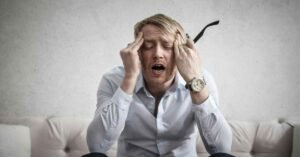
Have you ever felt a sharp pain in lower back when sneezing? You’re not alone. Many people experience this discomfort. It’s important to understand why this happens and what you can do about it. Here you can explore the common causes of lower back pain when sneezing, ways to prevent it, and some effective remedies to help you find relief.
Common Causes of Pain In Lower Back When Sneezing
1. Pulled Muscle
One of the most common causes of lower back pain when sneezing is pulled muscle which is also called muscle strain. Sneezing involves a unexpected, forceful movement that can strain the muscles and ligaments in your lower back. This strain can cause pain if these muscles are already tight or weak.
2. Spinal Disc Issues
Sneezing can increase pressure on the spinal discs in your lower back. If you have conditions like herniated discs or degenerative disc disease, this added pressure can aggravate the problem and cause pain. The discs act as cushions between the bones in your spine, and any issue with them can lead to discomfort.
3. Poor Posture
Poor posture is another common culprit. If you slouch or have weak core muscles, your spine does not get the support it needs. This lack of support can lead to pain when you sneeze. Good posture is essential for maintaining a healthy spine and preventing lower back pain.
4. Spinal Misalignment
Spinal misalignment or minor vertebral subluxations can also be triggered by sneezing. This misalignment can cause pain as your body tries to compensate for the sudden movement. Regular chiropractic care or physical therapy can help address these issues.

How to Prevent The Pain
1. Strengthen Your Core
Strengthen core means, able to maintain the body in ideal postures to unload the joints and promote ease of movement. It is essential for supporting your spine. Incorporate exercises like planks, bridges, and leg raises into your routine to build core strength. A stronger core will help stabilize your spine and reduce the risk of pain when sneezing.
2. Maintain Good Posture
It is most important to maintain good posture for preventing lower back pain. Make sure you sit and stand up straight, with your shoulders back and your spine in a neutral position. Avoid dropping or leaning forward for long periods.
3. Stretch Regularly
Regular stretching can help keep your muscles flexible and reduce the risk of strain. Focus on stretching your lower back, hamstrings, and hip flexors. Gentle yoga poses like child’s pose and cat-cow can also be beneficial.
4. Use Proper Lifting Techniques
Use your legs when lifting heavy objects. That means first bend your knees and keep the object close to you. Avoid twisting your spine while lifting. Using proper lifting techniques can prevent muscle strain and lower back pain.
5. Stay Active
You should include at least 20 to 30 minutes of moderate exercise in your daily routine. It keeps your muscles strong and flexible. Activities like walking, swimming, and jogging are great for maintaining a healthy back.
Remedies for Lower Back Pain
1. Apply Ice or Heat
If you experience lower back pain after sneezing, applying ice or heat can help. Ice can reduce inflammation and numb the pain, while heat can relax tense muscles. You can use cold pack or a heating pad for 10-20 minutes all at once.
2. Take Over-the-Counter Pain Relievers
Over-the-counter pain relievers can be helpful to reduce pain and inflammation. In this regards you should consult with the healthcare professional.
3. Practice Gentle Stretches
Gentle stretching can help alleviate lower back pain. Try stretches like the knee-to-chest stretch or the seated forward bend. Hold each stretch for 15-25 seconds and repeat it frequently in a day.
4. Stay Hydrated
Drinking plenty of water can help keep your discs and muscles hydrated. Proper hydration is essential for maintaining the health of your spine and preventing lower back pain.
5. Use a Supportive Mattress
A good mattress can make a big difference in preventing lower back pain. Choose a mattress that provides adequate support and comfort for your spine. You should replace your mattress if it is old or sagging.
When Need Doctor’s Advice

If your lower back pain when sneezing is severe, persistent, or accompanied by other symptoms like numbness, tingling, or weakness, it’s important to seek medical attention. Because a healthcare professional can properly diagnose your health condition and can prescribe you a proper treatment.
Conclusion
Now we can make a conclusion, that is lower back pain when sneezing can be uncomfortable, but there are steps you can take to prevent and alleviate it. By understanding the common causes, maintaining good posture, strengthening your core, and using proper techniques, you can reduce your risk of pain. If you do experience pain, try the remedies mentioned above and don’t hesitate to seek medical advice if needed. Remember, taking care of your back is essential for overall health and well-being. Stay active, stay hydrated, and listen to your body to keep your lower back healthy and pain-free.
FAQ
1. Why does my lower back hurt when I sneeze?
Lower back pain when sneezing can be caused by muscle strain, spinal disc issues, poor posture, or spinal misalignment. The sudden force of a sneeze can put extra pressure on these areas, leading to discomfort.
2. Can sneezing cause a slipped disc?
Sneezing itself is unlikely to cause a slipped (herniated) disc, but it can aggravate an existing condition. If you already have a disc issue, the pressure from sneezing can make it worse, leading to increased pain.
3. How can I prevent lower back pain when sneezing?
To prevent lower back pain when sneezing, maintain good posture, strengthen your core muscles, and practice regular stretching. Avoid slouching and use proper lifting techniques to reduce the risk of injury.
4. Is it normal to have back pain when sneezing?
While it’s not uncommon to feel some discomfort when sneezing, persistent or severe pain is not normal. If your pain continues or worsens, it’s a good idea to consult a healthcare professional.
5. Should I see a doctor for lower back pain when sneezing?
If the pain is severe, persistent, or accompanied by other symptoms like numbness, tingling, or weakness, you should see a doctor. Because, these may be the sign of a more serious condition.
6. Can sneezing cause sciatica?
Sneezing can aggravate sciatica if you already have the condition. The sudden pressure from sneezing can irritate the sciatic nerve, leading to pain that radiates down the leg.
7. What should I do if I feel a sharp pain in my lower back after sneezing?
If you feel sharp pain after sneezing, try resting, applying ice or heat to the affected area, and taking over-the-counter pain relievers. If the pain persists, consider seeing a healthcare professional.
8. Can poor posture cause lower back pain when sneezing?
Yes, poor posture can contribute to lower back pain when sneezing. Slouching or having weak core muscles can lead to strain on your back, making you more prone to pain during sudden movements like sneezing.














